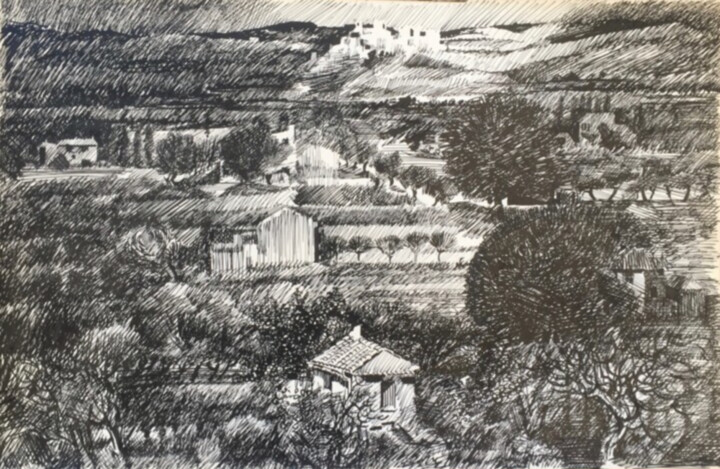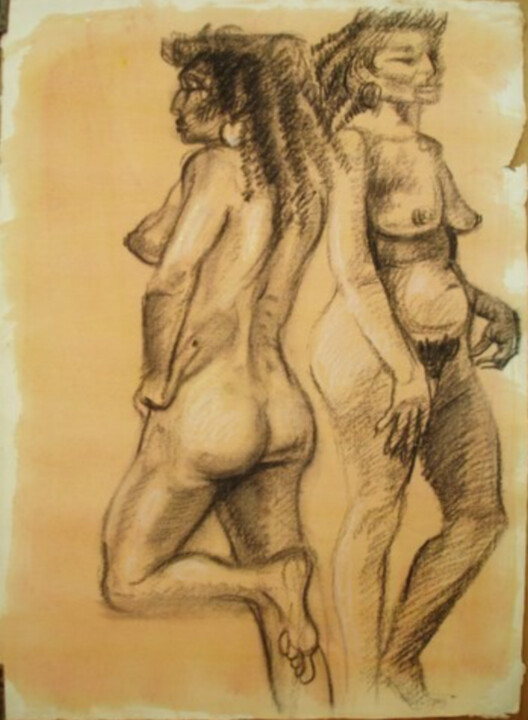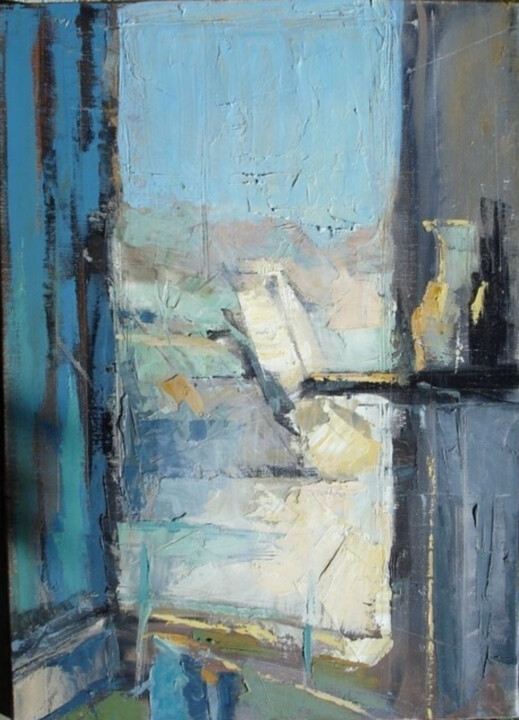
Moskovtchenko, Autoportrait, painting 46 cm × 38 cm, 2017, via Wikipedia.
Michel Moskovtchenko, born on January 6, 1935, in Tarare (Rhône), is a versatile artist whose creative journey spans painting, sculpture, drawing, and engraving. Settling in Lyon from 1953 and later making Roussillon (Vaucluse) his home since 1960, Moskovtchenko's artistic evolution reflects a deep engagement with both urban and rural landscapes, blending influences from his early urban upbringing with the serene beauty of his later surroundings in Vaucluse. His works are celebrated for their expressive depth and technical mastery, embodying a lifelong exploration of form, color, and narrative within the realms of visual art.
Artist Biography: Michel Moskovtchenko
Michel Moskovtchenko, born on January 6, 1935, in Tarare (Rhône), was influenced by his Russian physician father and French pianist-painter mother. Growing up in Violay (Loire), he was surrounded by art and music, fostering his early creativity. His interest in printmaking began in primary school with the Freinet method. After studying at the Collège moderne et technique de Tarare and taking evening drawing classes, he worked as a draftsman in Lyon while attending the École nationale supérieure des beaux-arts. During this time, he formed friendships with notable artists and cultural figures.
Between 1954 and 1956, Moskovtchenko traveled through Europe, studying engraving masters. He settled in Roussillon (Vaucluse) in 1960, initially focusing on drawing before moving to etching with the help of German artist Hans Hermann Steffens. His first solo exhibition was in Lyon in 1961. Extensive travels to places like Sicily, Spain, North Africa, and Scotland deeply influenced his work. The Hoggar region inspired a significant series of engravings showcased at the 1983 FIAC. Moskovtchenko also explored new techniques and led printmaking workshops at various cultural institutions.
From 1998, he shared his life with sculptor Colette Fizanne. His art, often described as "artistic geology," reflects a fascination with nature's textures and forms. Art historian Jan de Maere and critic Jean Clair consider him a leading figure in France's Nouvelle subjectivité movement. His motifs, noted for their complexity and intensity, convey a sense of human finitude and the raw power of nature.
Gordes-et-le-Bastidon (1960) by Michel Moskovtchenko
Michel Moskovtchenko, Gordes-et-le-Bastidon, 1960. Drawing, on Paper, Pen and India ink, 32.5cm x 49.6cm.
Gordes-et-le-Bastidon is a figurative landscape drawing by Michel Moskovtchenko, created in 1960. Using pen and India ink, Moskovtchenko meticulously captures the village of Gordes as seen from the plateau of Cabiscol. The artwork features a detailed portrayal of the village with its houses nestled among trees and set against a backdrop of mounts, highlighting the serene and picturesque nature of the region. The drawing showcases Moskovtchenko's skill in rendering intricate details and textures, offering a glimpse into the tranquil and timeless charm of Gordes.
Nancy: 2 Poses à Apt (1993) by Michel Moskovtchenko
Michel Moskovtchenko, Nancy: 2 Poses à Apt, 1993. Drawing, Other, 56cm x 40cm.
Nancy: 2 Poses à Apt is a compelling drawing by Michel Moskovtchenko, created in 1993. This evocative piece is executed in charcoal on tinted paper, providing a rich and textured backdrop that adds depth to the artwork. The drawing features two feminine silhouettes, presenting two women in different poses. One figure is depicted from the front, exuding a sense of openness and vulnerability, while the other is viewed from the back, offering a contrasting perspective that highlights the curves and contours of the female form. This duality provides a comprehensive study of the female body from varying angles, showcasing Moskovtchenko's keen observational skills and his ability to capture the essence of his subjects. The tinted paper used for this drawing, initially rejected by the printer, adds an additional layer of intrigue and character to the piece. The paper includes two distinct watermarks, one of which interestingly depicts a woman seated in a crescent moon, adding a subtle, almost ethereal quality to the composition. These watermarks not only enhance the visual appeal of the drawing but also contribute to its narrative depth, inviting viewers to ponder the stories behind these marks and their connection to the depicted figures. Moskovtchenko's use of charcoal allows for a range of tonal variations, from deep, velvety blacks to delicate, whisper-like grays, creating a dynamic interplay of light and shadow. This technique highlights the anatomical precision and artistic sensitivity with which he approaches the human form.
La Porte I (1986) by Michel Moskovtchenko
Michel Moskovtchenko, La Porte I, 1986. Oil Painting, 46cm x 33cm.
La Porte I, painted by Michel Moskovtchenko in 1986, is an evocative abstract oil painting that invites viewers into an imaginative exploration of both interior and exterior spaces. The composition features what appears to be an open window, through which one can vaguely discern hints of the outside world. Abstract forms suggest the presence of the ocean and houses, rendered in a way that leaves their exact nature to the viewer's imagination, thereby engaging them in a personal interpretation of the scene. Inside the room, Moskovtchenko includes a delicately painted vase positioned on a suspended shelf to the side. This element adds a tangible touch to the otherwise abstract environment, grounding the composition with a hint of domestic familiarity. The juxtaposition of the abstract exterior view and the detailed interior object creates a dynamic tension within the painting, prompting viewers to consider the relationship between the internal and external worlds. Moskovtchenko's use of oil paints allows for a rich interplay of colors and textures, enhancing the abstract quality of the piece while also providing depth and complexity. The viewer is encouraged to contemplate what lies beyond the window, letting their imagination fill in the details suggested by the painting's abstract forms.
Iconic Artworks
Michel Moskovtchenko's oeuvre spans a diverse range of themes and locations, each series showcasing his distinctive style and evolving artistic vision. His early works from 1949 to 1953, Paysages et arbres autour de Tarare, capture the serene landscapes and trees of his hometown. Between 1956 and 1958, his travels inspired Les Voyages, les musées, la Grand-Place de Bruxelles and Les Bateaux: Le Pirée, Schéveningue, reflecting his impressions of various European cities and ports. The period from 1965 to 1969 saw him depict the Les Hameaux en ruine en Provence and Les Hurdes en Espagne, focusing on rural decay and stark landscapes. The Série des Murs (1970) and Les Cèdres dans l'Atlas (1974-1980) explore textured surfaces and majestic cedar trees, while Le Cirque de Mourèze and Les Muriers (1974-1980) delve into natural formations and mixed media. His Autoportraits (1978-2017) and Nus (1988-2017) present intimate, personal reflections. The grand formats of Hoggar (1986) highlight the raw beauty of the Sahara. Other notable series include Carrières à Carrare and Carrières à Lacoste (1982-1986), Venise (1982-1986), Les labours, Les Maladrets, and L'Afrique (1988-2017), each capturing unique landscapes and cultural impressions. In the 2000s, he continued to explore new terrains with Paysages de Transylvanie (2006) and Le Luberon (2006-2008). His work Le chêne bleu (2006-2007) and Souvenirs de Grèce (2007) further exemplify his versatile mastery of different environments and artistic techniques.
Exhibition History
Michel Moskovtchenko has had a prolific exhibition history, showcasing his work in numerous solo and group exhibitions across Europe. His solo exhibitions began in the early 1960s, with notable displays at Galerie Malaval in Lyon, Galerie von der Hoh in Hamburg, and Galerie Le Lutrin in Lyon. Over the years, he exhibited regularly in Lyon, Paris, Stockholm, and Brussels, including significant shows at the Musée des beaux-arts de Lyon and the Centre Georges-Pompidou. His works were also featured in various group exhibitions, such as the Biennale de Paris, Rencontre lyonnaise, and the Foire internationale d'art contemporain at the Grand Palais in Paris. Moskovtchenko's collaborative exhibitions with other artists, such as Ivan Theimer, and participation in thematic shows like "La nouvelle subjectivité" at ELAC in Lyon, further cemented his reputation in the art world. His sculptures, drawings, and paintings continued to be displayed in prestigious venues into the 21st century, including the Musée national Brukenthal in Romania and Galerie MB-XL contemporary & modern in Brussels.
His work has been celebrated for its dynamic and powerful execution, likened to the dramatic and forceful Mistral wind by critic Hanns Theodor Flemming. Jean-Noël Vuarnet praised Moskovtchenko’s ability to blur the lines between the natural elements, creating dream-like realities that capture the essence of Provence in a lyrical yet rigorous manner. Jean-Pierre Geay highlighted Moskovtchenko’s talent in transforming the light and landscape of the Luberon into tangible, emotive experiences. Jean-Jacques Lévêque noted the majestic yet fragile nature of Moskovtchenko’s work, while Bruno Marcenac described his etchings as both haunting and hopeful, capturing the mystical essence of the Luberon. Michèle Crozet and Jacques Leenhardt emphasized Moskovtchenko’s commitment to drawing, seeing his line work as both elemental and expressive. Gérard Xuriguera and Jean-Michel Foray remarked on the stark, almost lifeless landscapes that evoke a sense of desolation and fear, while the Bénézit Dictionary highlighted his sensitivity to the arid landscapes of Provence. Jean Jacques Larrant vividly described Moskovtchenko’s exploration of the provocative and surreal elements in nature, turning the ordinary into the fantastical.
In conclusion, Moskovtchenko's artistic journey, spanning over seven decades, stands as a testament to his profound exploration of form, color, and narrative in visual art. From his early influences in Lyon to his deep engagement with the landscapes of Vaucluse, Moskovtchenko's work evolved dynamically, reflecting a fusion of urban sophistication and rural tranquility. His ability to capture the essence of places like Gordes and the Sahara, as well as the human form through his drawings and paintings, showcases his mastery of technique and sensitivity to his surroundings. Celebrated for his expressive depth and technical prowess, Moskovtchenko's legacy resonates through his diverse series and exhibitions across Europe, solidifying his place as a prominent figure in contemporary art. His work continues to inspire with its intricate textures, vibrant colors, and poignant reflections on nature and humanity, leaving a lasting imprint on the art world and beyond.





 Selena Mattei
Selena Mattei












